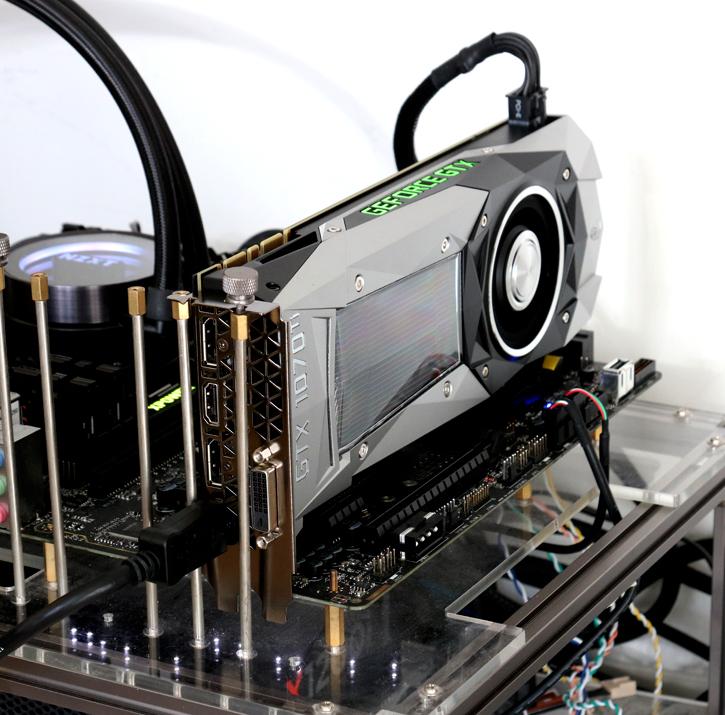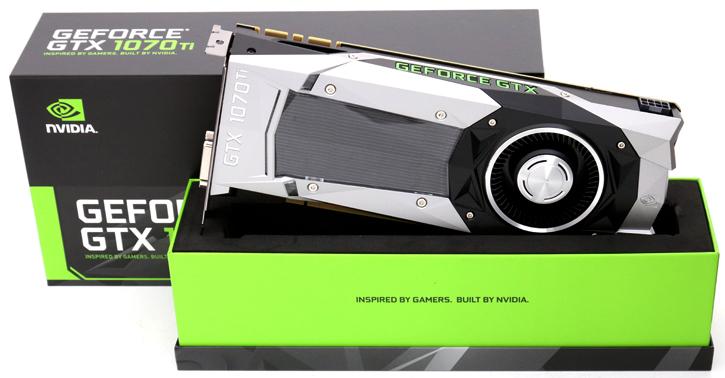Conclusion
Conclusion
So there you have it, the founders' edition GeForce GTX 1070 Ti. When AMD launched Radeon RX Vega 56 and 64, the one product of the two where Nvidia did not really have a direct answer for was that Vega 56. That's probably why they figured, hmm it's almost Christmas season, let's make sure we have the Vega 56 to 64 gap covered. And so the new baby Ti was born. To do so the took the GP104, reconfigured it a bit and then realized they needed to slow it the heck down, as it quite easily can match the GeForce GTX 1080 in performance. This is mainly the reason why you will see the AIB partners all offering their 1070 Ti cards at the same clock frequencies; see an even faster product would cannibalize that GeForce GTX 1080. Guess what? Grab the latest beta of our homegrown MSI AfterBurner (we already updated it for the 1070 Ti) and tweak the fracker until that smile on your face is bigger than the length of a GTX 1080 Founder Edition. The reference card is running ~80 Degrees C under full load. However, you can still apply a tweak as suggested and have this new card bring in a nice gain up-to (let's say) 10% in performance. And that certainly is interesting. As always, the performance on all models including tweaking results is all more or less the same due to the restrictions Nvidia applies. If the cooler is good enough, throttling will not occur. Hence differentiation in design, noise levels, and cooling is key and king to and for the board partners. One problem for the 1070 Ti, however, is that it is going to sit in a very saturated segment, people that wanted Pascal already will have purchased a 1070 or 1080 in my belief. So for this product to make real sense, it needs a sharp and edgy low price. Is it a 400 Euro/USD card really? We do think so.
Aesthetics
For the entire 1060 / 1070 / 1070 Ti /1080 series compared to the previous gen products, Nvidia tweaked the aesthetics of the cooler a bit as you now see triangles/polygons embedded in the cooler shell, resembling the core essence 3D objects are made of, of course. Being a very expensive card they probably should have considered making it a bit more mysterious looking with a black shell, especially at with a premium for the Founders Editions. The GeForce GTX logo on top some might dislike, it surely doesn't bother me though and that see-through Plexiglass in the cooler makes it look quite nice. Overall it's just a good looking and sturdy product. We like the fact that it has a backplate though but completely dislike the fact that it has no meshes and gaps for more ventilation on that backside. The design, as is, will trap heat. As you can see, I remain skeptical about backplates, they can trap heat and thus warm up the PCB. But the flip-side is that they do look better and can protect your PCB and components from damage.
Cooling & Noise Levels
The cooling itself really is at the same level it was, you can't really complain about it. A bit trivial of course remains the temperature targets that Nvidia is using. The default setting for the GTX 1070 Ti will be, give or take, 80 degrees C, meaning these cards are allowed to run to 80 Degrees C before ramping up the fan RPM to try to keep the product cool at 80 Degrees C. Nvidia feels this is a nice balance in-between performance, power consumption, and temperatures. Most of you would, however, prefer something a little lower temperature and noise levels wise. You can obviously change the temperature target of the fan RPM yourself, that will ramp up the noise levels though. But at up-to 80 degrees C and at that level the noise levels are okay really. In idle you can barely hear the cooling solution and under stress, well you can hear some airflow and that's it.
Power Consumption
Any GP104 Pascal GPU and thus GP104 based graphics card is rated as having a 180 Watt TDP under full stress, our measurements show it to be a fair assessment in the 170 Watt range. At this level you are looking at a card that consumes roughly 400~450 Watts for a stressed PC (in total), that is okay. We think a 500~600 Watt PSU would be very sufficient and, if you go with 2-way SLI, a 750 Watt power supply is recommended. It's definitely more than needed but remember - when purchasing a PSU, aim to double up in Wattage as your PSU is most efficient when it is under 50% load. Here, again, keep in mind we measure peak power consumption, the average power consumption is a good notch lower depending on GPU utilization. Also, if you plan to overclock the CPU/memory and/or GPU with added voltage, please do purchase a power supply with enough reserve. People often underestimate it, but if you tweak all three aforementioned variables, you can easily add 200 Watts to your peak power consumption budget as increasing voltages and clocks increase your power consumption.
Overall gaming performance
If you game at a resolution of 1920x1080 (Full HD) up-to 2560x1440 (WQHD) then the 1070 Ti series is going to be very sufficient. The card does sit in a nice high-end (but not enthusiast) range that will suit many of you just fine. If you stick to the aforementioned resolutions then there's not one game that won't run really good combined with the best image quality settings. Gaming you must do with a nice 24" monitor of course, at 2560x1440/1600 would actually be a perfect fit. The 8GB graphics memory is excellent, making the product more future proof. Starting with Pascal the primary focus for Nvidia in terms of multi-GPU setups is that they will support 2-way SLI, but really that's it and all.
Overclocking
Due to the many limiters and hardware protections, Nvidia has built in, all and any cards will hover roughly at or just over the 2.0 GHz level on the Boost marker. Now, the one factor that can actually positively influence the boost speed a little is temperature as the GPU will then throttle less. And that did show as we could boost to 2050~2100 MHz, that is stable. On 3DMark Firestrike with this card tweaked (for example) it may hover at ~2075 MHz, while in Rise of the Tomb Raider (2016) you will be closer to 2.1 GHz. The reality is that Nvidia monitors and adapts to hardware specific loads, e.g. an application that is nearly viral like on the GPU will have the effect of the GPU protecting itself by lowering clocks and voltages. The opposite applies here as well, if a game does not try to fry that GPU, it'll clock a bit faster within the tweaked thresholds at your disposal. The AIB cards are much less noisy when tweaked though ! Heck silent even.
Concluding
Nvidia did what it needed to do, create an alternative proposition towards Radeon Rx Vega 56, really that's all that this product is about aside from the fact to also create a new SKU for the Holiday season. The problem, however, is that most people already will have bought a 1070 or 1080, and seen from that perspective I doubt that the Ti would be very appealing to them. Also, the ones that will need a graphics upgrade probably will go with the cheaper SKU, the GTX 1070. The ones that can spend more money probably will sit it out and wait on Volta. In that mindset, I find the Ti a bit of a difficult to position release that seems to primarily fills a gap just to match the Vega 56 and 64. So, compared to that Vega 56 or GTX 1070 the 1070 Ti is merely a small step up in additional performance and that alone is probably not enough to justify an upgrade if you are already fragging away in that Vega56/Vega64/1070/1080 performance bracket. The GTX 1070 Ti series is however lovely for up-to 2560x1440 gaming. In relative performance, the Ti offers good performance and you will gain from a nice manual overclock, but so will that regular 1070, of course. Overall we think that the 1070 Ti is looking good from most viewpoints, it is a little beast with a growl and bites for the Full HD and WQHD gamers combined with the proper image quality settings and a graphics memory reserve to even go a little crazy. The price, however, is decisive, and with the regular 1070 dropping in price to make room for the GeForce 1070 Ti, that regular 1070 actually might be the better deal. Tweak it a bit and you are done and with a good enough GPU, you'll still reach GTX 1080 performance levels.
Recommended Downloads
- Sign up to receive a notice when we publish a new article
- Or go back to Guru3D's front page




